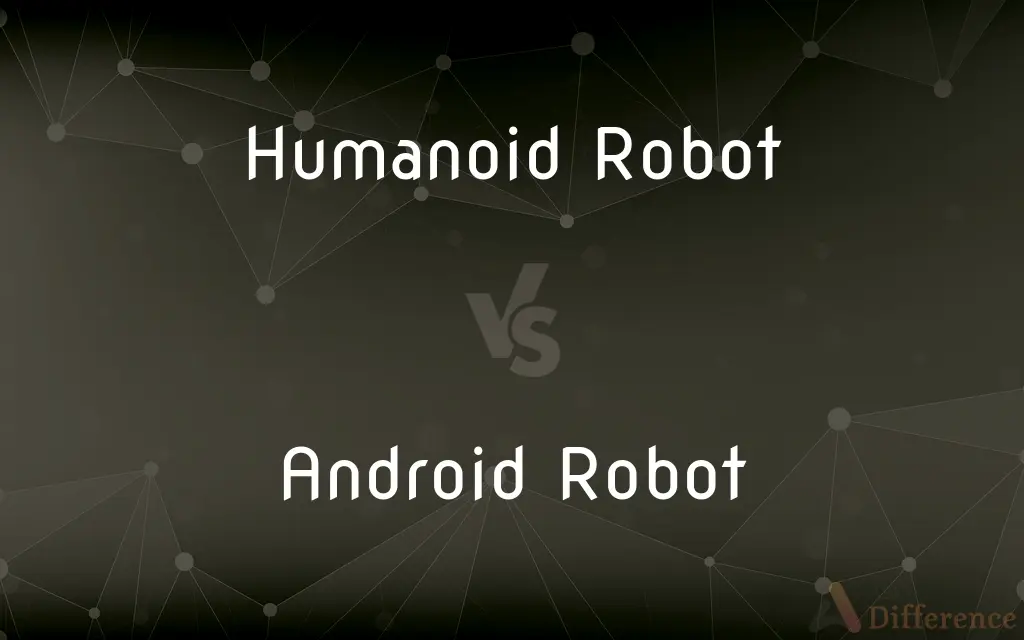Humanoid Robot vs. Android Robot — What's the Difference?
By Maham Liaqat & Urooj Arif — Published on May 18, 2024
Humanoid robots are designed to resemble the human body, focusing on replicating general human functions, while androids specifically mimic human appearance and behaviors more closely.

Difference Between Humanoid Robot and Android Robot
Table of Contents
ADVERTISEMENT
Key Differences
Humanoid robots are engineered to resemble the human body's structure and capabilities, aiming for a general replication of human motions and tasks. They might be used in various fields, including manufacturing, healthcare, and service industries, to perform tasks that require human-like mobility and dexterity.
Android robots, a subset of humanoid robots, are distinguished by their specific focus on emulating human appearance and behavior as closely as possible. Androids are designed to look like humans, often with realistic skin, hair, and facial features, and mimic human expressions and movements precisely.
Humanoid robots usually have a bipedal design to navigate environments built for humans, equipped with sensors and actuators to interact with their surroundings and handle objects. Their appearance can range from clearly robotic to somewhat lifelike, depending on their intended function and the importance of their interaction with humans. While Android robots are primarily used in roles that benefit from a human-like presence, such as customer service, caregiving, and educational roles, or as subjects in human-robot interaction research. The development of androids emphasizes creating robots that can not only perform tasks but also engage with people on a more personal and emotional level.
The key difference between humanoid and android robots lies in their degree of resemblance to humans, both in appearance and behavior. While humanoid robots are designed for functional similarity, androids aim for an in-depth replication of the human form and social behaviors, making them more suitable for interactive roles that require a high level of human likeness.
Comparison Chart
Design Goal
Replicate human body structure and mobility
Closely mimic human appearance and behaviors
ADVERTISEMENT
Appearance
From robotic to somewhat lifelike
Highly lifelike, with human-like skin, hair, etc.
Primary Use
General tasks requiring human-like mobility
Interaction-focused roles, human-robot interaction research
Mobility
Bipedal, capable of navigating human environments
Often bipedal, with a focus on smooth, human-like movements
Interaction Level
Basic interaction with environment and objects
Advanced, including facial expressions and speech
Technological Focus
Mobility, dexterity
Lifelike appearance, behavior, and emotional intelligence
Examples
Manufacturing robots, service robots
Customer service robots, caregiving robots
Compare with Definitions
Humanoid Robot
Designed for environments built for humans.
Humanoid robots in warehouses picking and placing goods.
Android Robot
Used in roles that benefit from a human-like presence.
Actroid, used in Japanese museums to interact with and guide visitors.
Humanoid Robot
May have a robotic appearance with some human-like features.
Pepper, a social humanoid robot, interacts with people using a tablet for a face.
Android Robot
Often incorporates realistic materials for skin and hair.
Androids used in customer service with lifelike expressions to interact with customers.
Humanoid Robot
Focuses on replicating human actions and movements.
Robonaut, developed by NASA, assists astronauts with tasks in space.
Android Robot
Emphasizes emotional intelligence and social interactions.
Geminoid robots created by Hiroshi Ishiguro for studies in human-robot interaction.
Humanoid Robot
A robot with a human-like body structure designed for a wide range of tasks.
ASIMO, developed by Honda, can walk, run, and navigate stairs.
Android Robot
Aims for seamless integration into human social settings.
Androids serving as receptionists in hotels, providing information and assistance to guests.
Humanoid Robot
Equipped with sensors and actuators for interaction and mobility.
Boston Dynamics' Atlas performs complex movements and obstacle navigation.
Android Robot
A robot designed to closely resemble a human in appearance and behavior.
Hanson Robotics' Sophia can mimic facial expressions and engage in conversation.
Common Curiosities
Can androids perform the same tasks as humanoid robots?
While androids can perform many of the same tasks, their design prioritizes interaction and human-like behavior over physical tasks.
What's the main difference between a humanoid robot and an android?
The main difference lies in their appearance and function; humanoid robots are designed for tasks requiring human-like mobility, while androids focus on closely mimicking human appearance and social behaviors.
Are android robots more advanced than humanoid robots?
Androids are often more advanced in terms of lifelike appearance and social interaction capabilities, but not necessarily in performing physical tasks.
How are humanoid robots and androids powered?
Both are typically powered by electric motors and batteries, with some models incorporating advanced power sources like fuel cells.
Why use android robots instead of humanoid robots for customer service?
Androids provide a more relatable and engaging experience for humans, leveraging their lifelike appearance and behavior to improve customer interaction.
Can humanoid robots recognize and respond to human emotions?
Some advanced humanoid robots are equipped with AI that allows them to recognize and respond to basic human emotions, though androids typically excel in this area.
Is it more expensive to develop an android than a humanoid robot?
Yes, the additional complexity of creating lifelike appearances and behaviors generally makes androids more expensive to develop.
Can android robots learn from their interactions with humans?
Yes, many androids are equipped with AI that allows them to learn and adapt from interactions, improving their responses and behaviors over time.
Are there ethical concerns with creating robots that closely resemble humans?
Yes, ethical concerns include the potential for deception, privacy issues, and the impact on human jobs and social interactions.
What future developments can we expect in humanoid and android robotics?
Future developments may include enhanced AI, more lifelike materials for androids, improved mobility for humanoid robots, and greater integration into daily human activities.
Share Your Discovery

Previous Comparison
Trolleys vs. Trollies
Next Comparison
Maple vs. MathematicaAuthor Spotlight
Written by
Maham LiaqatCo-written by
Urooj ArifUrooj is a skilled content writer at Ask Difference, known for her exceptional ability to simplify complex topics into engaging and informative content. With a passion for research and a flair for clear, concise writing, she consistently delivers articles that resonate with our diverse audience.













































